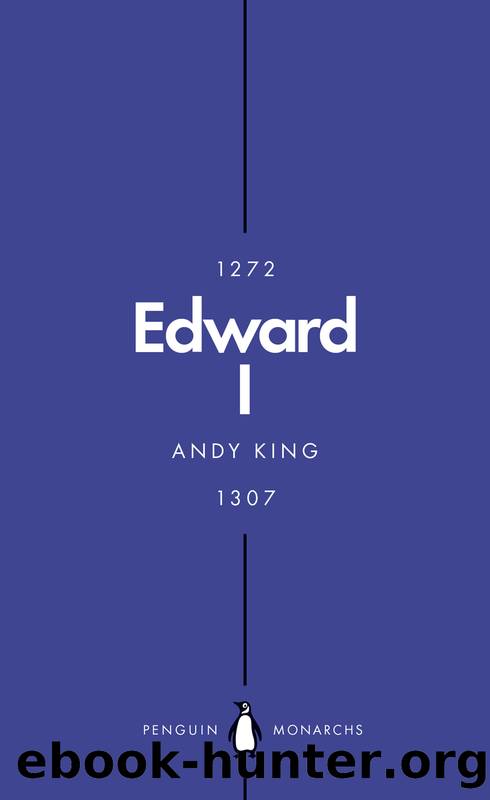Edward I by Andy King

Author:Andy King [King, Andy]
Language: eng
Format: epub
ISBN: 9780141978789
Publisher: Penguin Books Ltd
Published: 2016-10-17T00:00:00+00:00
Meanwhile, after protracted negotiations, an agreement to end the Anglo-French war had been reached in June 1299. The planned marriage alliance was revived, and on 10 September, attended by great pomp and ceremony, Edward took Margaret of France as his second wife. Nevertheless, the French continued to support the Scots, and gave shelter to the exiled John Balliol, in whose name the Scots were resisting. Both sides lobbied for the support of the papacy, backing their cases with appeals to ancient history: Edward claimed an English overlordship stretching back beyond the time of King Arthur, while the Scots countered that their kings, who they claimed were descended from Scota, the daughter of a Pharaoh, had always enjoyed full sovereignty.
In the summer of 1302, however, events conspired to dramatically improve Edward’s position in France – and, consequently, in Scotland – for a revolt broke out in Flanders, where the French were attempting to impose direct rule. The flower of France’s chivalry suffered an unexpected and shattering defeat at the hands of common Flemish townsmen, at Courtrai (news of the battle was received with enormous satisfaction in England). In the face of this disaster, and the urgent need to reimpose French control in Flanders, Philip IV was impelled to settle his remaining differences with his new brother-in-law. In May 1303, the duchy of Aquitaine was formally restored to Edward. Furthermore, Philip now abandoned his support for the Scots; in return, Edward renounced any support for the Flemings. In effect, the status quo ante was restored; Edward thus finally managed to emerge from war with France with his French lands undiminished. If this was, perhaps, as much down to luck as judgement, it was certainly more than his father or grandfather had been able to achieve.
Finally, Edward had a free hand in Scotland; in June 1303, he mustered another army at Roxburgh, of some 7,500 foot soldiers and 580 men-at-arms. Serving with him was Robert Bruce, Earl of Carrick, who had submitted in February 1302, unwilling to continue fighting for the restoration of Balliol’s kingship. For the first time, Edward managed to keep a substantial force in Scotland over the winter. Allowed no respite, abandoned by Philip and the pope, and with their king still languishing in exile, increasing numbers of Scots came to the conclusion that there was nothing to be gained by prolonging their resistance. Early in 1304, John Comyn, the leader of Edward’s Scottish opponents, yielded. Stirling Castle, the last outpost of Scottish resistance, finally surrendered on 20 July. And Edward was, once again, ruler of all the British Isles.
Having learned the lessons of 1296–7, Edward’s settlement with the Scots was pragmatic, rather than vindictive, working with the grain of Scottish political society. Admittedly, his ordinance ‘for the good order of the land of Scotland’ relegated the kingdom to the status of a ‘land’;16 but the Scots were now allowed greater influence in its government. Although the highest-ranking offices were reserved for Englishmen (with Edward’s nephew, John of Brittany, as
Download
This site does not store any files on its server. We only index and link to content provided by other sites. Please contact the content providers to delete copyright contents if any and email us, we'll remove relevant links or contents immediately.
Blood and Oil by Bradley Hope(1529)
Wandering in Strange Lands by Morgan Jerkins(1372)
Ambition and Desire: The Dangerous Life of Josephine Bonaparte by Kate Williams(1344)
Daniel Holmes: A Memoir From Malta's Prison: From a cage, on a rock, in a puddle... by Daniel Holmes(1293)
It Was All a Lie by Stuart Stevens;(1265)
Twelve Caesars by Mary Beard(1256)
The First Conspiracy by Brad Meltzer & Josh Mensch(1140)
What Really Happened: The Death of Hitler by Robert J. Hutchinson(1128)
London in the Twentieth Century by Jerry White(1112)
Time of the Magicians by Wolfram Eilenberger(1089)
The Japanese by Christopher Harding(1086)
Twilight of the Gods by Ian W. Toll(1084)
Cleopatra by Alberto Angela(1062)
A Woman by Sibilla Aleramo(1052)
Lenin: A Biography by Robert Service(1045)
The Devil You Know by Charles M. Blow(985)
Reading for Life by Philip Davis(971)
The Life of William Faulkner by Carl Rollyson(925)
1965--The Most Revolutionary Year in Music by Andrew Grant Jackson(920)
